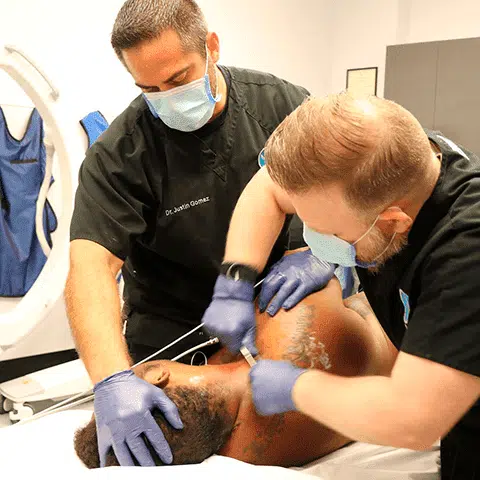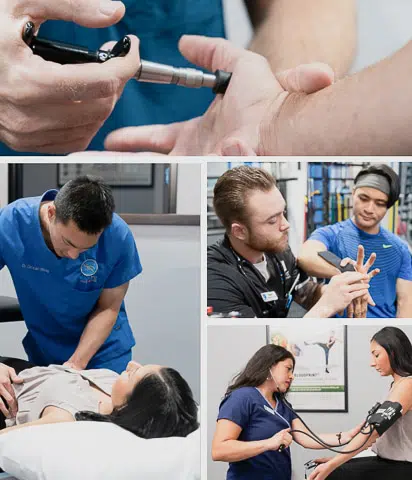Manipulation Under Anesthesia

Appointment Inquiries
Chiropractic Home Exercise Education Massage Therapy Physical Therapy
Call us at: (877) 222-5348
Overview
Manipulation under anesthesia is the mobilization, passive stretching, and traction procedures performed on soft tissues while a patient is under sedation.
Symptoms Treated
Ankle Pain, Back Pain, Chronic Sprain, Disk Problems, Failed Back Surgery Sundrome, Fibromyalgia, Frozen Shoulder, Headaches + Migraines, Hip Pain, Knee Pain, Muscle Spapsms, Pinched Nerves
Performed By
Doctor of Chiropractic
Complementary Treatments
Chiropractic, Home Exercise Education, Massage Therapy, Physical Therapy
What is Manipulation Under Anesthesia (MUA)?
Manipulation under anesthesia is a safe, non-invasive procedure to treat chronic pain, improve range of motion, and break up excessive internal scar tissue and fibrous adhesions. MUA consists of a series of soft tissue mobilization, passive stretching, and traction procedures performed while a patient receives anesthesia.
MUA is a multidisciplinary treatment usually performed by at least two outpatient specialists collaborating. It is only performed by medical professionals that have specifically studied MUA and received certification in the technique. Normal practitioners include chiropractors, anesthesiologists, orthopedic surgeons, and osteopaths. The MUA procedure has been well-studied and practiced for decades.
Anesthesia is an integral part of MUA. Depending on the patient, sedation may be local such that only a single area is numbed. However, in many cases, a waking general anesthesia will be applied, inducing what’s sometimes called a “twilight state.”
Anesthesia is used to reduce pain, muscle spasms, and reflex “guarding” that may interfere with manual therapies while awake and alert. By combining manipulation and anesthesia, an MUA practitioner can use less force on adhesions and bypass normal patient resistance.
Not everyone qualifies for manipulation under anesthesia. More conservative treatments are almost always attempted first such as chiropractic care, physical therapy, and trigger point injections. If your current treatment is not working, MUA may be recommended.
It is most often recommended for chronic back pain, shoulder pain, and knee pain.
It is also prescribed for:
- Adhesive capsulitis
- Ankle pain
- Arthrofibrosis
- Chronic sprains
- Degenerative disc disease
- Dislocations
- Failed back surgery syndrome
- Fibromyalgia
- Frozen shoulder
- Headaches
- Herniated discs
- Hip pain
- Migraines
- Myofascial pain syndrome
- Muscle spasms
- Neck pain
- Nerve entrapment
- Post-surgery rehabilitation
- Whiplash
The cost of MUA is often covered by insurance as a viable alternative to surgery or dependence on opioids.
Manipulation under anesthesia is not appropriate for patients with or that have had a stroke, osteoporosis, bone cancer, uncontrolled diabetes, heart disease, uncontrolled hypertension, or acute inflammatory arthritis.
What should I expect during an MUA treatment?
Manipulation under anesthesia varies in length depending on what is being treated, but treatments are usually under 20 minutes. For improved results, an MUA treatment plan may be a series that can repeat for up to 4 consecutive days. MUA is completed in a private procedure room.
Once anesthesia is applied, a patient’s joints are moved and stretched through their full range of motions. Low intensity, repetitive stretching through MUA is proven to address long-term pain. In many cases, spinal MUA, chiropractic adjustments, or scraping may also be performed to break barriers to movement. As scar tissue is broken down, the joint restriction is reduced resulting in neutral muscle tension and increased range of motion.
After the procedure, the patient will experience an immediate increase in mobility, as well as probably feel tired and sore. MUA treatment is not unlike a hard exercise session even though the movements were performed by others on the patient. After treatment, the patient is given time to recover from the anesthesia, then discharged home to rest. Normal daily activity can usually be resumed the following day.
Short-term heating and ice is usually appropriate for short-term discomfort. A prescription anti-inflammatory may also be prescribed to assist in recovery.
Note that you will not be allowed to drive following MUA. Please make arrangements for a ride personally or with us prior to treatment.
What happens after the procedure?
An MUA treatment plan is not complete without further supporting rehabilitation after the procedure(s). Within 1 day to 10 days, a program of physical therapy for 3 to 8 weeks will maximize the success of MUA. Electrostimulation, manual therapies such as massage, and chiropractic care may also be recommended and beneficial.
The post-MUA therapy program helps maintain the results achieved during the MUA procedure. A regimented program will help you regain both pre-pain strength and help prevent future disability.
If you suffer from chronic pain, you may be a candidate for manipulation under anesthesia. Please feel free to reach out to discuss.
Make an appointment Today!
Looking to learn more? Explore our locations, treatments, or our new patient offer below or contact one of the BackFit Family of staff to have your questions answered.


